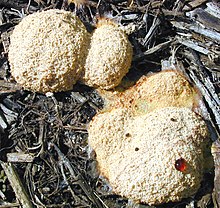Mycetozoa
| Mycetozoa | |
|---|---|

| |
| Aethalium jamur lendir (Fuligo septica) | |
| Klasifikasi ilmiah | |
| Domain: | |
| (tanpa takson): | |
| Kerajaan: | |
| Subfilum: | |
| Infrafilum: | Mycetozoa de Bary, 1873
|
| Kelas dan ordo | |
| Sinonim | |
| |
Mycetozoa adalah pengelompokan jamur lendir.[2]
Klasifikasi
Mycetozoa dapat dibagi menjadi kelompok Dictyostelia, Myxogastria, dan Protostelia.[3]
Kelompok-kelompok mycetozoa termasuk dalam supergrup unikonta Amoebozoa, sementara sebagian besar jamur lendir lain termasuk dalam berbagai kelompok bikonta (fonticulida adalah opisthokonta).
Kegunaan dalam penelitian
Dictyostelida digunakan sebagai contoh dalam komunikasi dan diferensiasi seluler, dan dapat memberikan wawasan tentang bagaimana organisme multiseluler berkembang.
Meiosis
Anggota kelompok Mycetozoa dapat melakukan reproduksi seksual baik dengan perkawinan heterotalik atau homotalik[4][5][6] Sebiah analisis dari gen-gen yang terkait dengan meiosis dalam genom Dictyostelium discoideum menunjukkan bahwa 36 dari 44 gen yang dites ada dalam genom tersebut.[7] Satu gen, Spo11, tidak ada di Mycetozoa, memunculkan pertanyaan tentang asumsi bahwa Spo11 memiliki peran universal sebagai inisiator dari meiosis.[7]
Galeri
-
Slime mold on lawn, USA. Trail of movement can be seen.
-
Brefeldia maxima on a tree stump in Scotland.
Referensi
- ^ Whittaker, R. H. (1969). New concepts of kingdoms or organisms Diarsipkan 2017-11-17 di Wayback Machine.. Science 163 (3863): 150–160.
- ^ "Mycetozoa - Definition from Merriam-Webster's Medical Dictionary". Diakses tanggal 2009-03-27.
- ^ Baldauf SL, Doolittle WF (October 1997). "Origin and evolution of the slime molds (Mycetozoa)". Proc. Natl. Acad. Sci. U.S.A. 94 (22): 12007–12. doi:10.1073/pnas.94.22.12007. PMC 23686
 . PMID 9342353.
. PMID 9342353.
- ^ Robson GE, Williams KL (1980). "The mating system of the cellular slime mould Dictyostelium discoideum". Curr. Genet. 1 (3): 229–32. doi:10.1007/BF00390948. PMID 24189663.
- ^ Flowers JM, Li SI, Stathos A, Saxer G, Ostrowski EA, Queller DC, Strassmann JE, Purugganan MD (2010). "Variation, sex, and social cooperation: molecular population genetics of the social amoeba Dictyostelium discoideum". PLoS Genet. 6 (7): e1001013. doi:10.1371/journal.pgen.1001013. PMC 2895654
 . PMID 20617172.
. PMID 20617172.
- ^ O'Day DH, Keszei A (2012). "Signalling and sex in the social amoebozoans". Biol Rev Camb Philos Soc. 87 (2): 313–29. doi:10.1111/j.1469-185X.2011.00200.x. PMID 21929567.
- ^ a b Tekle YI, Wood FC, Katz LA, Cerón-Romero MA, Gorfu LA (2017). "Amoebozoans are Secretly but Ancestrally Sexual: Evidence for Sex Genes and Potential Novel Crossover Pathways in Diverse Groups of Amoebae". Genome Biol Evol. doi:10.1093/gbe/evx002. PMID 28087686.
Pranala luar
- Slime Molds
- Slime Mold Solves Maze Puzzle from abc.net.au
- Hunting Slime Molds Diarsipkan 2009-09-27 di Archive-It from Smithsonian Magazine
- "Robot Piloted by a Slime Mold". Slashdot. 2006. Diakses tanggal February 15, 2006.
- dictyBase is an online informatics resource for Dictyostelium, a cellular slime mould.
- nomen.eumycetozoa.com Diarsipkan 2010-03-02 di Wayback Machine. is an online nomenclatural information system of slime moulds (Myxomycetes, Dictyostelids and Protostelids) of the world.
- Photo gallery Diarsipkan 2016-10-13 di Wayback Machine.
- Introduction to the "Slime Molds"
- Slime Mold Photos Life cycle of Reticularia lycoperdon at MushooMania.com.



